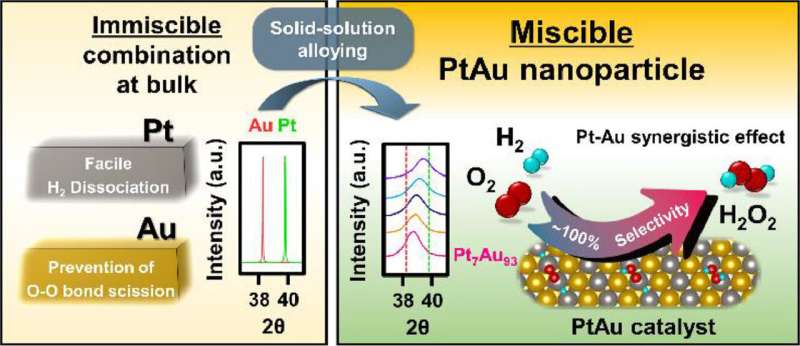Gold-platinum nanoparticle composite schematic. Credit: Korea Institute of Science and Technology (KIST)
Hydrogen peroxide diluted in water is used as a disinfectant to treat wounds. It is widely used across the industry as an eco-friendly oxidizing agent for removing impurities from semiconductors, for waste treatment, and other applications. Currently, it is mainly produced by the sequential hydrogenation and oxidation of anthraquinone (AQ). However, this process is not only energy intensive and requires large-scale facilities, but AQ is also toxic.
As an alternative to the AQ process, researchers have proposed direct hydrogen peroxide synthesis from hydrogen (H2) and oxygen (O2) using a palladium (Pd) catalyst. However, the commercialization of the technology has been challenging because the amount of water (H2O) formed is greater than hydrogen peroxide (H2O2) during the process.
At the Korea Institute of Science and Technology (KIST), a joint research team of Dr. Sang Soo Han and Dr. Donghun Kim (Computational Science Research Center), Dr. Seung Yong Lee (Materials Architecture Research Center), and Professor Kwan-Young Lee at Korea University (Korea University, President Jin Taek Chung) have developed a platinum-gold alloy catalyst for hydrogen peroxide production based on a computer simulation. Hydrogen peroxide selectivity can be increased to 95% by using this catalyst, compared with only 30-40% for a palladium catalyst, which indicates that hydrogen peroxide results from the Pt-Au catalyst with only a small amount of water.
Although it is difficult to homogeneously mix Pt and Au to develop an alloyed catalyst due to the intrinsic immiscibility of the metals, the researchers successfully synthesized nanoparticles in the form of alloys by forcibly reducing precursors of Pt and Au. Also, using this method, the content of each metal particle could be controlled by adjusting the amount of precursors of Pt and Au.
Hydrogen peroxide can be produced anywhere without large equipment by simply injecting both hydrogen gas and oxygen gas into an aqueous solution using the new catalyst. Unlike the Pd catalyst, the Pt-Au catalyst can produce hydrogen peroxide up to 95% even at ambient temperature (10 degrees C) and atmospheric pressure (1 atm). In addition, a catalytic reaction can be maintained for longer than eight hours due to the structural stability of the catalyst.
The researchers clearly established the crystal structure of Pt-Au alloy nanoparticles by performing additional computer simulations, which is difficult to solve using general material analysis techniques. Sang Soo Han, head of the Center at KIST, said, "It is important that the developed catalysts provide an eco-friendly hydrogen peroxide production option that can be applied without any limitation of manufacturing sites. Therefore, commercialization for hydrogen peroxide direct synthesis would be greatly accelerated by overcoming the limitation of Pd catalysts with the low selectivity. The time and cost for the development of novel catalysts, mainly explored through trial and error, could be considerably reduced through computer simulations."
More information: Hong Woo Lee et al, Solid-solution alloying of immiscible Pt and Au boosts catalytic performance for H2O2 direct synthesis, Acta Materialia (2020). DOI: 10.1016/j.actamat.2020.116563
Provided by National Research Council of Science & Technology
























